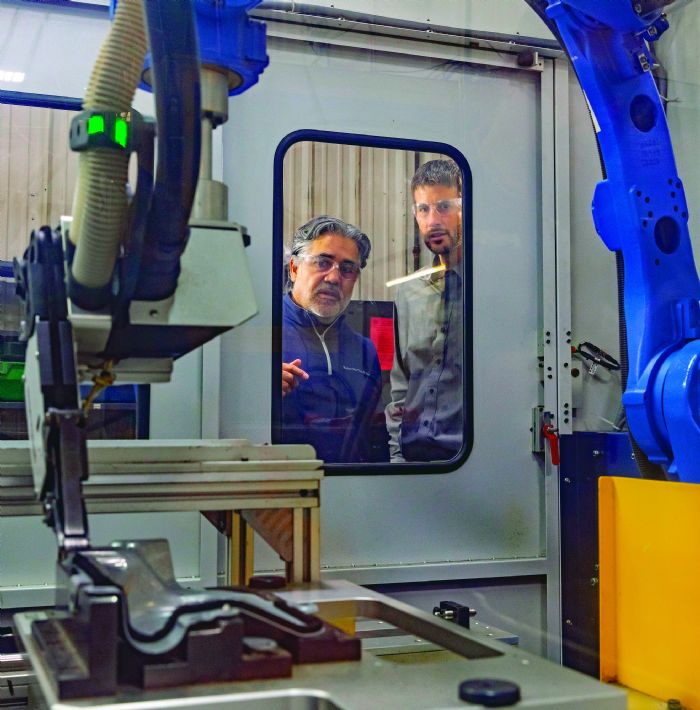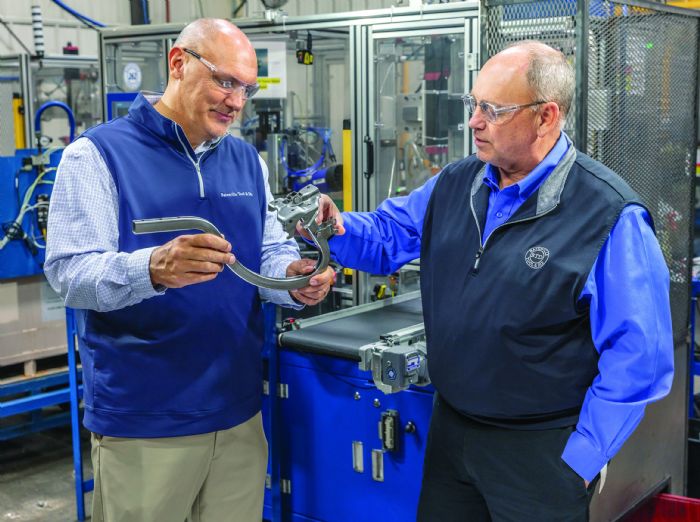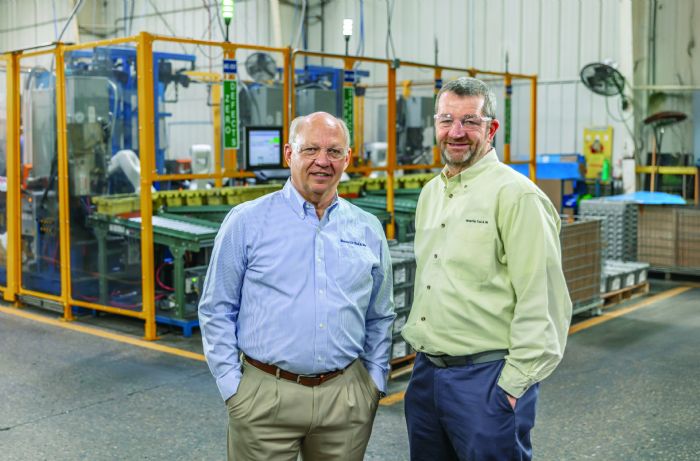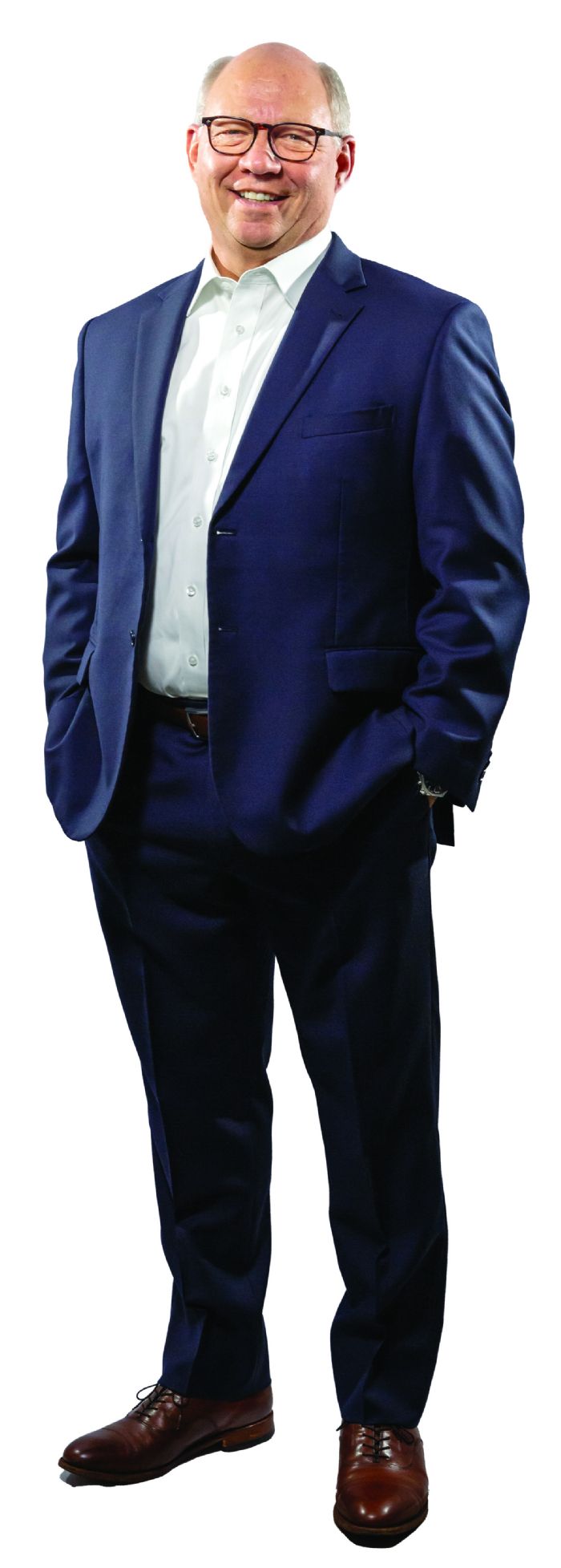Evolving to Accommodate Shrinking Order Volumes
BTD, which, besides its headquarters plant in Batesville, also operates facilities in Aiken, SC, and Queretaro, Mexico, produces stampings and assemblies for 11 major global OEMs in the automotive, recreational-vehicle, heavy-truck and appliance industries, along with a long list of Tier One customers. Among the three facilities, BTD operates 81 stamping presses.
 “Components and assemblies are more complex today, representative of our advanced manufacturing technology,” explains Lambert. “That’s where automation helps, structuring the workflow to produce complete multi-part assemblies in one multiprocess production cell, rather than moving subassemblies around the plant from operation to operation. The result is significantly reduced work in process, as much as 30% less for some operations, and a similar gain in production efficiency and quality.”
“Components and assemblies are more complex today, representative of our advanced manufacturing technology,” explains Lambert. “That’s where automation helps, structuring the workflow to produce complete multi-part assemblies in one multiprocess production cell, rather than moving subassemblies around the plant from operation to operation. The result is significantly reduced work in process, as much as 30% less for some operations, and a similar gain in production efficiency and quality.”
All of that helps BTD to cope with and adjust to volume reductions in the automotive marketplace, notes Lambert.
“Several years ago, we had numerous programs running annual volumes of 500,000 and more,” he says. “Today the average volume is 250,000 and shrinking.”
Along with investing in new automation equipment, to the tune of more than $3.5 million/yr. during the last few years, BTD recently doubled the square footage at its e-coat facility in Tipton, IN; installed a 1000-ton press at its Batesville facility in 2024, where it currently is installing a 630-ton servo press; installed an 800-ton press at its facility in Mexico in 2024; and will install a 250-ton press at its South Carolina plant in 2025.
On the workforce front, the company remains committed to recruiting, training and retaining a younger workforce, continuing its relationship with local trade school Ivy Tech Community College and the high schools in the community. MetalForming detailed that relationship when BTD CEO Jody Fledderman served as PMA board chairman in 2014.
“That workforce-development program remains strong,” Lambert says. “In fact, we now house the Ivy Tech tooling-training facility here at BTD. Bringing the students here for their hands-on training allows them to become acclimated with our environment and meet our people, which turns into a great recruiting tool for us.”
All In with PMA
|
Gene Lambert, VP of sales at metal former Batesville Tool & Die, reflects on an upbringing that practically predestined him to work in manufacturing: “My father had a tool shop in our garage, and was extremely mechanical, always working on a lathe or machining center to repair tractors or engines of some kind. He’d find them in a field in disrepair, or neighbors would bring him work. Of course, I spent a lot of time out there working alongside him.” Shortly after Lambert graduated from high school, his father learned that local manufacturer Batesville Tool & Die, just a few minutes from the family home, was looking for an apprentice. He brought the idea to Gene, and the rest is history—46 yr. of history.
“When I started here in November of 1978, one of my first jobs was building a bathroom onsite,” he recalls. “The facility, acquired at the time by Ron Fledderman (father of current majority owner and CEO Jody Fledderman), had been a warehouse and did not have a bathroom. My first paycheck was double what I had been earning previously, which amounted to a lot of money for a teenager.” In a short amount of time, Lambert moved into the BTD toolroom and completed his journeyman toolmaker apprenticeship, in 1983. A year later, Ron Fledderman asked him to establish a quality system for the company. “It was pretty loose; we only had a couple of presses at that time,” Lambert continues. “But I established a quality department with defined, written quality instructions, we implemented SPC, etc. Then, when Ron Fledderman decided to move to Florida full time, I was promoted to VP of sales.” At that time, the company had three outside sales agencies. “They just wanted to chase smokestacks,” Lambert recalls, “paying little to no attention to customer service. They weren’t technical.” After a couple of years, Lambert moved the sales inhouse and built a new sales team. “At first we primarily promoted technical people from various areas of the company,” he says, “people who we thought would represent our company well and who understood the processes, the causes and effects, and the terminology.” BTD now operates from three locations—with four sales associates working from its Mexico location and one in its South Carolina plant, in addition to six sales people in Indiana. While Lambert oversees all sales and cost estimating efforts, his primary duty, he says, is new-business development. “When we started our Mexico plant in 2000, I served as project manager,” Lambert recalls. “I immediately found that the workers bring to BTD a tremendous work ethic; they want to succeed and grow within the company. In fact, over the years we’ve brought some of our employees from the Mexico facility up to Batesville, including one of our outstanding sales associates who now handles two of our key OEM customers.” In managing his sales team, Lambert hires with a focus on salesmanship, and then invests in the technical training needed to learn the business. “We’ve even put new sales associates out on the plant floor,” he says, “to, for example, follow a toolmaker around. We want them to understand the different die processes, progressive versus transfer, and to be able to look at a part and understand how best to form it.” |
Following the direction set forth by Fledderman, whose engagement with PMA dates back to the origins of BTD in 1978, Lambert became involved with the association in 2001. As his introduction to PMA, Lambert participated with the association’s sales and marketing group, regularly attending its annual Sales & Marketing Roundtable. In 2005 he took over as chair of that group.
“In 2019, I joined the newly christened PMA Cellars Group, a networking group within the association focused on sales and marketing topics. Originally called the Sales & Marketing Executive Networking Group when launched in 2017, Troy Turnbull (PMA’s 2020 board chair and president of Industrial Innovations), renamed it Cellars. Members are decisionmakers at their companies—higher-level executive leaders.”
Cellars is one of five executive networking groups within PMA, along with a sixth networking group formed specifically for mid-level managers. “Part of the success of these groups—each of which has its own, unique overriding theme—is consistency and longevity,” Lambert explains. “As we develop close relationships with other group participants, we feel comfortable sharing experiences and information with each other.”
Furthering his PMA activities, in 2016 Lambert took over as director of the PMA Indiana district. Most recently, the district, in 2021, launched its first exposition for local manufacturers. He then partnered with two other associations—the National Tooling & Machining Association and the Indiana Manufacturers Association—to help grow the expo.
“Three years in, the event is flourishing,” says Lambert, who also has served PMA at the national level on several of the association’s committees including dues revenue, audit and finance.
Topping the “To-Do” List: New-Member Onboarding
As PMA continues to develop opportunities for its members to network and share best practices, the goal, as noted, is getting more members involved. The strategy starts with fine-tuning the new-member experience, beginning with a focus on onboarding.
“Our local districts will have a lot of say on how we build this experience for new members,” says PMA membership engagement manager Randy Kish, “which becomes increasingly important as we prioritize reaching deeper into the ranks of new member companies. We want to focus on the key people at each company and get them engaged at the local level, as quickly as possible. This is especially the case with younger professionals and those new to the industry. This allows PMA to truly optimize the value of membership and then enables the district leaders to look at opportunities for new members to volunteer and begin to contribute to PMA’s efforts locally.”
To ramp up these efforts, Kish will work with PMA’s district leaders to share results of the strategic planning that PMA has undertaken.
“During the last several months, the PMA management team has been hard at work defining and developing a strategic direction, vision and goals,” says PMA president David Klotz. “That work will continue with support from Gene Lambert.”
One objective of an elevated new-member onboarding process, Kish explains, is to enable existing members to connect with new members, to share their experiences with PMA and explain the value of membership. “Our longtime member companies include PMA in their organizational culture,” he says. “They’re eminently able to validate the value that companies gain through their membership.”
Ultimately, the key is engagement at the district level, and Kish and his team are working to put in place the tools that PMA members can use to enable that new-member engagement.
“From PMA headquarters, we will empower our district leaders to help guide us in developing these tools,” he says. “Listening and responding to their member experiences will be key to success.”
 Also on Kish’s agenda during 2025: support PMA’s installation of a new association-management system (think ERP for associations). That, along with a redesigned PMA website, will, among other benefits, allow Kish and the membership team to create focused member communities within the greater association based on specific interests.
Also on Kish’s agenda during 2025: support PMA’s installation of a new association-management system (think ERP for associations). That, along with a redesigned PMA website, will, among other benefits, allow Kish and the membership team to create focused member communities within the greater association based on specific interests.
Lastly, during Lambert’s year as board chair, PMA will prioritize evolving its workforce-development initiatives, including custom in-plant training and the PMA METALFORM EDU online-training platform. That work takes place under the direction of Connie King, PMA’s workforce development director, and Dean Phillips, director of technical training.
Building PMA’s Strategy for the Next Generation
For his year as PMA board chair, Lambert remains committed to carrying forward the work begun in 2024.
“When you make the decision to start on a journey, which is what we did in 2024, you have to understand that it takes time, that it’s a process,” says Boucher, setting the table for Lambert. “We made the commitment, and now we’re working as an organization to ensure that people have buy-in and understand what we’re collectively trying to accomplish.”
Lambert continues: “As we’ve been able to validate the information gathered, we’ve begun to develop a strategy in those areas that we think are most important to the success of PMA—the new-member onboarding process previously discussed is a good example,” he says. “Workforce development is another area that we’ll focus on, as well. This is not a process for one chairman serving a 1-yr. term. It’s a journey during which, in 2025, we’ll really start to see the rubber hit the road and develop some traction, resulting in real, productive change—for PMA and its members.”
On the Lobbying Front
While the coming year brings opportunity for PMA and the industry, it also brings uncertainty from Washington, D.C. Says PMA lobbyist Omar Nashashibi:
“PMA is helping lead the way to prevent more than $4 trillion in tax increases on manufacturers, if Congress does not act by the end of 2025. We are working with lawmakers to eliminate the tax on R&D activity, restoring 100% expensing for capital equipment and making permanent the lower tax rate for passthrough businesses. We have a seat at the table at the highest levels on Capitol Hill today because of the work of our members, our association leadership and our partners in Washington, D.C.
“When our members travel to the nation’s capital in April,” Nashashibi continues, “they will carry with them the importance of investment in our domestic industry in the face of global competition. This second Trump administration is off to a fast start putting its mark on trade. PMA is preparing for the renegotiation of the new NAFTA, lobbying on Chinese subsidies and serving as the lone voice against tariffs on imported metal from our allies.
“Finally, a successful workforce strategy involves a public-private partnership, from the federal government to local nonprofits, educators and parents,” Nashashibi says. “During the last several years, we have seen the public and policymakers alike rethink careers in manufacturing, and that is due in part to the public relations efforts led by PMA and our team in Washington.
“Our voice remains critical on issues such as taxes, trade, regulations and workforce.” MF
View Glossary of Metalforming Terms
See also: Precision Metalforming Association
Technologies: Management, Pressroom Automation







 Meeting with BTD VP of sales Gene Lambert, who’s preparing to take the reins of the board of the Precision Metalforming Association (PMA) as chair for 2025, it’s clear that BTD understands well the need to continuously evolve to meet the challenges facing the metal forming community. He also brings that understanding to PMA, looking to continue the theme established by 2024 PMA board chair Gregg Boucher. That is:
Meeting with BTD VP of sales Gene Lambert, who’s preparing to take the reins of the board of the Precision Metalforming Association (PMA) as chair for 2025, it’s clear that BTD understands well the need to continuously evolve to meet the challenges facing the metal forming community. He also brings that understanding to PMA, looking to continue the theme established by 2024 PMA board chair Gregg Boucher. That is: To help direct these efforts, in 2024 PMA hired strategy consultant Paul Kessler, managing director of the Altus Group. Kessler’s work continues in 2025, helping to lead the PMA management team through the process of strategizing. The goal: develop a process to better serve its members and promote longevity in the organization. Now, Lambert takes up the initiative where Boucher left off. While he believes that growing PMA membership remains one of the association’s overall goals, he’s very focused on increasing member engagement and participation.
To help direct these efforts, in 2024 PMA hired strategy consultant Paul Kessler, managing director of the Altus Group. Kessler’s work continues in 2025, helping to lead the PMA management team through the process of strategizing. The goal: develop a process to better serve its members and promote longevity in the organization. Now, Lambert takes up the initiative where Boucher left off. While he believes that growing PMA membership remains one of the association’s overall goals, he’s very focused on increasing member engagement and participation.

